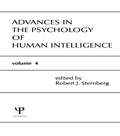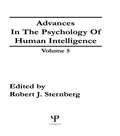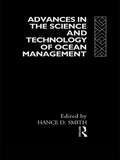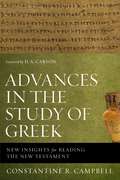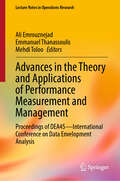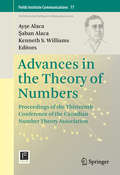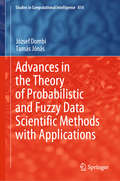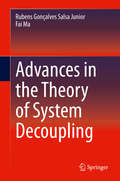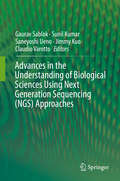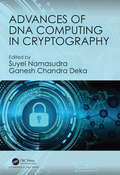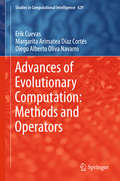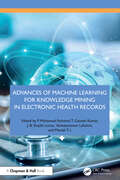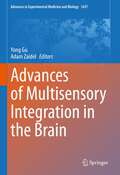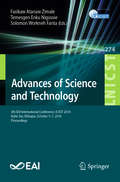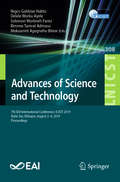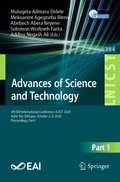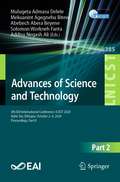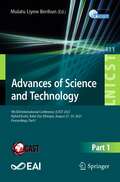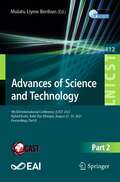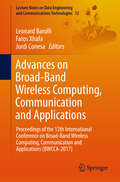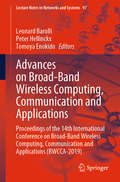- Table View
- List View
Advances in the Psychology of Human Intelligence: Volume 4
by Robert J. SternbergFirst published in 1987. Routledge is an imprint of Taylor & Francis, an informa company.
Advances in the Psychology of Human Intelligence: Volume 5
by Robert J. SternbergVolume five continues to mark the significant advances made in the psychology of human intelligence, problem solving, and thinking abilities. Papers contributed by leaders in the field reflect a diversity of perspectives and approaches to the human intelligence. Subjects discussed include: * genetic and environmental contributions to information-processing abilities * development of children's conceptions of intelligence * skill acquisition as a bridge between intelligence and motivation * information-processing abilities underlying intelligence * costs of expertise and their relation to intelligence * the nature of abstract thought
Advances in the Science and Technology of Ocean Management (Routledge Advances in Maritime Research)
by Hance SmithThis book reviews key developments in the field of marine science and technology. It focuses on three major themes such as the importance of technical developments in ocean management, the application of these developments to specific sea uses ranging from fish farming to the disposal of industrial waste, and the long-term issues that such developments raise.
Advances in the Study of Bilingualism
by Ineke Mennen Enlli Môn ThomasThis book provides a contemporary approach to the study of bilingualism. Drawing on contributions from leading experts in the field, this book brings together - in a single volume - a selection of the exciting work conducted as part of the programme of the ESRC Centre for Research on Bilingualism in Theory and Practice at Bangor University, Wales. Each chapter has as its main focus an exploration of the relationship between the two languages of a bilingual. Section by section, the authors draw on current findings and methodologies to explore the ways in which their research can address this question from a number of different perspectives.
Advances in the Study of Greek: New Insights for Reading the New Testament
by D. A. Carson Constantine R. CampbellAdvances in the Study of Greek offers an introduction to issues of interest in the current world of Greek scholarship. Those within Greek scholarship will welcome this book as a tool that puts students, pastors, professors, and commentators firmly in touch with what is going on in Greek studies. Those outside Greek scholarship will warmly receive Advances in the Study of Greek as a resource to get themselves up to speed in Greek studies. Free of technical linguistic jargon, the scholarship contained within is highly accessible to outsiders.Advances in the Study of Greek provides an accessible introduction for students, pastors, professors, and commentators to understand the current issues of interest in this period of paradigm shift.
Advances in the Theory and Applications of Performance Measurement and Management: Proceedings of DEA45—International Conference on Data Envelopment Analysis (Lecture Notes in Operations Research)
by Ali Emrouznejad Emmanuel Thanassoulis Mehdi TolooThis book presents selected proceedings of DEA45: International Conference on Data Envelopment Analysis, which was held September 4-6, 2023, at Surrey Business School, University of Surrey, Guildford, UK. It contains theoretical and empirical papers on Data Envelopment Analysis (DEA) and related fields with a focus on performance measurement and management. It discusses the latest research and developments and their application in various areas such as regulation, agriculture, education, financial and health services. The book is of interest to both researchers and practitioners working on or utilizing the DEA method for examining efficiencies across various organizations.
Advances in the Theory of Numbers: Proceedings of the Thirteenth Conference of the Canadian Number Theory Association (Fields Institute Communications #77)
by Kenneth S. Williams Ayşe Alaca Şaban AlacaThe theory of numbers continues to occupy a central place in modern mathematics because of both its long history over many centuries as well as its many diverse applications to other fields such as discrete mathematics, cryptography, and coding theory. The proof by Andrew Wiles (with Richard Taylor) of Fermat's last theorem published in 1995 illustrates the high level of difficulty of problems encountered in number-theoretic research as well as the usefulness of the new ideas arising from its proof. The thirteenth conference of the Canadian Number Theory Association was held at Carleton University, Ottawa, Ontario, Canada from June 16 to 20, 2014. Ninety-nine talks were presented at the conference on the theme of advances in the theory of numbers. Topics of the talks reflected the diversity of current trends and activities in modern number theory. These topics included modular forms, hypergeometric functions, elliptic curves, distribution of prime numbers, diophantine equations, L-functions, Diophantine approximation, and many more. This volume contains some of the papers presented at the conference. All papers were refereed. The high quality of the articles and their contribution to current research directions make this volume a must for any mathematics library and is particularly relevant to researchers and graduate students with an interest in number theory. The editors hope that this volume will serve as both a resource and an inspiration to future generations of researchers in the theory of numbers.
Advances in the Theory of Probabilistic and Fuzzy Data Scientific Methods with Applications (Studies in Computational Intelligence #814)
by József Dombi Tamás JónásThis book focuses on the advanced soft computational and probabilistic methods that the authors have published over the past few years. It describes theoretical results and applications, and discusses how various uncertainty measures – probability, plausibility and belief measures – can be treated in a unified way. It also examines approximations of four notable probability distributions (Weibull, exponential, logistic and normal) using a unified probability distribution function, and presents a fuzzy arithmetic-based time series model that provides an easy-to-use forecasting technique. Lastly, it proposes flexible fuzzy numbers for Likert scale-based evaluations. Featuring methods that can be successfully applied in a variety of areas, including engineering, economics, biology and the medical sciences, the book offers useful guidelines for practitioners and researchers.
Advances in the Theory of Quantum Systems in Chemistry and Physics: Conceptual And Computational Advances In Quantum Chemistry (Progress in Theoretical Chemistry and Physics #22)
by Jean Maruani Erkki J. Brändas Gerardo Delgado-Barrio Piotr Piecuch Philip E. HogganAdvances in the Theory of Quantum Systems in Chemistry and Physics is a collection of 32 selected papers from the scientific contributions presented at the 15th International Workshop on Quantum Systems in Chemistry and Physics (QSCP-XV), held at Magdalene College, Cambridge, UK, from August 31st to September 5th, 2010. This volume discusses the state of the art, new trends, and the future of methods in molecular quantum mechanics and their applications to a wide range of problems in chemistry, physics, and biology. The breadth and depth of the scientific topics discussed during QSCP-XV are gathered in seven sections: I. Fundamental Theory; II. Model Atoms; III. Atoms and Molecules with Exponential-Type Orbitals; IV. Density-Oriented Methods; V. Dynamics and Quantum Monte-Carlo Methodology; VI. Structure and Reactivity; VII. Complex Systems, Solids, Biophysics. Advances in the Theory of Quantum Systems in Chemistry and Physics is written for research students and professionals in Quantum systems of chemistry and physics. It also constitutes and invaluable guide for those wishing to familiarize themselves with research perspectives in the domain of quantum systems for thematic conversion or simply to gain insight into the methodological developments and applications to physics chemistry and biology that have actually become feasible by the end of 2010.
Advances in the Theory of System Decoupling
by Rubens Gonçalves Salsa Junior Fai MaThis book presents a concise, clear, and consistent account of the methodology of phase synchronization, an extension of modal analysis to decouple any linear system in real space. It expounds on the novel theory of phase synchronization and presents recent advances, while also providing relevant background on classical decoupling theories that are used in structural analysis. The theory is illustrated with a broad range of examples. The theoretical development is also supplemented by applications to engineering problems. In addition, the methodology is implemented in a MATLAB algorithm which can be used to solve many of the illustrative examples in the book. This book is suited for researchers, practicing engineers, and graduate students in various fields of engineering, mathematics, and physical science.
Advances in the Understanding of Biological Sciences Using Next Generation Sequencing (NGS) Approaches
by Sunil Kumar Gaurav Sablok Saneyoshi Ueno Jimmy Kuo Claudio VarottoProvides a global view of the recent advances in the biological sciences and the adaption of the pathogen to the host plants revealed using NGS. Molecular Omic's is now a major driving force to learn the adaption genetics and a great challenge to the scientific community, which can be resolved through the application of the NGS technologies. The availability of complete genome sequences, the respective model species for dicot and monocot plant groups, presents a global opportunity to delineate the identification, function and the expression of the genes, to develop new tools for the identification of the new genes and pathway identification. Genome-wide research tools, resources and approaches such as data mining for structural similarities, gene expression profiling at the DNA and RNA level with rapid increase in available genome sequencing efforts, expressed sequence tags (ESTs), RNA-seq, gene expression profiling, induced deletion mutants and insertional mutants, and gene expression knock-down (gene silencing) studies with RNAi and microRNAs have become integral parts of plant molecular omic's. Molecular diversity and mutational approaches present the first line of approach to unravel the genetic and molecular basis for several traits, QTL related to disease resistance, which includes host approaches to combat the pathogens and to understand the adaptation of the pathogen to the plant host. Using NGS technologies, understanding of adaptation genetics towards stress tolerance has been correlated to the epigenetics. Naturally occurring allelic variations, genome shuffling and variations induced by chemical or radiation mutagenesis are also being used in functional genomics to elucidate the pathway for the pathogen and stress tolerance and is widely illustrated in demonstrating the identification of the genes responsible for tolerance in plants, bacterial and fungal species.
Advances of Basic Science for Second Generation Bioethanol from Sugarcane: Bioethanol From Sugarcane And Their Impact On Technology
by Marcos S. Buckeridge Amanda P. De SouzaThis book focuses on the basic science recently produced in Brazil for the improvement of sugarcane as a bioenergy crop and as a raw material for 2nd generation bioethanol production. Part I details the development of some of the most important basic scientific tools needed for 2nd generation technologies of sugarcane in the domains of plant physiology and agricultural sciences and the domains of chemistry and biochemistry of plants and microorganisms. These include issues such as plant cell wall structure and architecture, physical characteristics of sugarcane biomass that are to be used for hydrolysis and fermentation in 2nd generation processes. Part II focuses on the development of the more applied sciences necessary to advance technological processes of pretreatment and hydrolysis of biomass and fermentation of the free sugars released from it. Some aspects of enzyme engineering are approached in this session and ends with a proposition of the assembly of an enzymatic cocktail based on the discoveries made by INCT-Bioethanol researchers after discovery of new enzymes among the Brazilian biodiversity of microorganisms. Part III examines the issue of how some key elements of basic science (Part I) have be applied to develop technologies for 2nd generation bioethanol (Part II). The translation from basic to applied sciences is highlighted as key for innovation using examples based on recent case studies in the area. In Part IV, a discussion about how policies that interconnect the scientific communities among scientists and the society in general of countries can help to accelerate or decelerate technological development depending on how efficient is communication among scientists, policy makers and industry.
Advances of DNA Computing in Cryptography
by Ganesh Chandra Deka Suyel NamasudraThis book discusses the current technologies of cryptography using DNA computing. Various chapters of the book will discuss the basic concepts of cryptography, steganography, basic concepts of DNA and DNA computing, approaches of DNA computing in cryptography, security attacks, practical implementaion of DNA computing, applications of DNA computing in the cloud computing environment, applications of DNA computing for big data, etc. It provides a judicious mix of concepts, solved examples and real life case studies.
Advances of Evolutionary Computation: Methods and Operators (Studies in Computational Intelligence #629)
by Erik Cuevas Margarita Arimatea Díaz Cortés Diego Alberto Oliva NavarroThe goal of this book is topresent advances that discuss alternative Evolutionary Computation (EC) developmentsand non-conventional operators which have proved to be eective in the solutionof several complex problems. The book has been structured so that each chaptercan be read independently from the others. The book contains nine chapters withthe following themes: 1) Introduction, 2) the Social Spider Optimization (SSO),3) the States of Matter Search (SMS), 4) the collective animal behavior (CAB)algorithm, 5) the Allostatic Optimization (AO) method, 6) the Locust Search(LS) algorithm, 7) the Adaptive Population with Reduced Evaluations (APRE)method, 8) the multimodal CAB, 9) the constrained SSO method.
Advances of Footprint Family for Sustainable Energy and Industrial Systems (Green Energy and Technology)
by Jingzheng RenThis book presents various methodologies for determining the ecological footprint, carbon footprint, water footprint, nitrogen footprint, and life cycle environment impacts and illustrates these methodologies through various applications. In particular, it systematically and comprehensively introduces the concepts and tools of the ‘footprint family’ and discusses their applications in energy and industrial systems. The book begins by providing an overview of the effects of the economic growth dynamics on ecological footprint and then presents the definitions, concepts, calculation methods, and applications of the various footprints. The unique characteristic of this book is that it demonstrates the applications of various footprints in different systems including economic system, ecological system, beef production system, cropping system, building, food chain, sugarcane bioproducts, and the Belt and Road Initiative. Providing both background theory and practical advice, the book is of interest to energy and environmental researchers, graduate students, and engineers.
Advances of Machine Learning for Knowledge Mining in Electronic Health Records
by Venkataraman Lakshmi T. Ganesh Kumar P. Mohamed Fathimal Shajilin Loret, J. B. T. I. ManishThe book explores the application of cutting-edge machine learning and deep learning algorithms in mining Electronic Health Records (EHR). With the aim of improving patient health management, this book explains the structure of EHR consisting of demographics, medical history, and diagnosis, with a focus on the design and representation of structured, semi-structured, and unstructured data. Explains the design of organized, semi-structured, unstructured, and irregular time series data of electronic health records Covers information extraction, standards for meta-data, reuse of metadata for clinical research, and organized and unstructured data Discusses supervised and unsupervised learning in electronic health records Describes clustering and classification techniques for organized, semi- structured, and unstructured data from electronic health records This book is an essential resource for researchers and professionals in fields like computer science, biomedical engineering, and information technology, seeking to enhance healthcare efficiency, security, and privacy through advanced data analytics and machine learning.
Advances of Multisensory Integration in the Brain (Advances in Experimental Medicine and Biology #1437)
by Yong Gu Adam ZaidelThis book presents the latest research on multisensory brain function. Namely, the mechanisms by which the brain processes and integrates information from multiple sensory modalities. Its contents cover a broad range of topics, including optimal integration, cross-modal interactions, calibration, and causal inference – with an emphasis on their neuronal underpinnings. By bringing together efforts from different laboratories around the world we aim to collaboratively shed light on these fundamental brain processes, that underlie perception, cognition, and behavior in a complex multisensory world, and to spur innovation of brain-inspired technologies
Advances of Science and Technology: 6th EAI International Conference, ICAST 2018, Bahir Dar, Ethiopia, October 5-7, 2018, Proceedings (Lecture Notes of the Institute for Computer Sciences, Social Informatics and Telecommunications Engineering #274)
by Fasikaw Atanaw Zimale Temesgen Enku Nigussie Solomon Workneh FantaThis book constitutes the refereed post-conference proceedings of the 6th International Conference on Advancement of Science and Technology, ICAST 2018, which took place in Bahir Dar, Ethiopia, in October 2018. The 47 revised full papers were carefully reviewed and selected from 71 submissions. The papers present economic and technologic developments in modern societies in five tracks: agro-processing industries for sustainable development, water resources development for the shared vision in blue Nile basin, IT and computer technology innovation, recent advances in electrical and computer engineering, progresses in product design and system optimization.
Advances of Science and Technology: 7th EAI International Conference, ICAST 2019, Bahir Dar, Ethiopia, August 2–4, 2019, Proceedings (Lecture Notes of the Institute for Computer Sciences, Social Informatics and Telecommunications Engineering #308)
by Solomon Workneh Fanta Nigus Gabbiye Habtu Delele Worku Ayele Bimrew Tamrat Admasu Mekuanint Agegnehu BitewThis book constitutes the refereed post-conference proceedings of the 7th International Conference on Advancement of Science and Technology, ICAST 2019, which took place in Bahir Dar, Ethiopia, in August 2019. The 76 revised full papers were carefully reviewed and selected from more than 150 submissions. The papers present economic and technologic developments in modern societies in five tracks: agro-processing industries for sustainable development, water resources and environmental engineering, recent advances in electrical, electronics and computing technologies, product design, manufacturing and systems organization, and material science and engineering.
Advances of Science and Technology: 8th EAI International Conference, ICAST 2020, Bahir Dar, Ethiopia, October 2-4, 2020, Proceedings, Part I (Lecture Notes of the Institute for Computer Sciences, Social Informatics and Telecommunications Engineering #384)
by Solomon Workneh Fanta Mekuanint Agegnehu Bitew Mulugeta Admasu Delele Abebech Abera Beyene Addisu Negash AliThis two-volume set constitutes the refereed post-conference proceedings of the 8th International Conference on Advancement of Science and Technology, ICAST 2020, which took place in Bahir Dar, Ethiopia, in October 2020.The 74 revised full papers were carefully reviewed and selected from more than 200 submissions of which 157 were sent out for peer review. The papers present economic and technologic developments in modern societies in 6 tracks: Chemical, food and bio-process engineering; Electrical and computer engineering; IT, computer science and software engineering; Civil, water resources, and environmental engineering; Mechanical and industrial engineering; Material science and engineering.
Advances of Science and Technology: 8th EAI International Conference, ICAST 2020, Bahir Dar, Ethiopia, October 2-4, 2020, Proceedings, Part II (Lecture Notes of the Institute for Computer Sciences, Social Informatics and Telecommunications Engineering #385)
by Solomon Workneh Fanta Mekuanint Agegnehu Bitew Mulugeta Admasu Delele Abebech Abera Beyene Addisu Negash AliThis two-volume set constitutes the refereed post-conference proceedings of the 8th International Conference on Advancement of Science and Technology, ICAST 2020, which took place in Bahir Dar, Ethiopia, in October 2020.The 74 revised full papers were carefully reviewed and selected from more than 200 submissions of which 157 were sent out for peer review. The papers present economic and technologic developments in modern societies in 6 tracks: Chemical, food and bio-process engineering; Electrical and computer engineering; IT, computer science and software engineering; Civil, water resources, and environmental engineering; Mechanical and industrial engineering; Material science and engineering.
Advances of Science and Technology: 9th EAI International Conference, ICAST 2021, Hybrid Event, Bahir Dar, Ethiopia, August 27–29, 2021, Proceedings, Part I (Lecture Notes of the Institute for Computer Sciences, Social Informatics and Telecommunications Engineering #411)
by Mulatu Liyew BerihunThis two-volume set of LNICST 411 and 412 constitutes the refereed post-conference proceedings of the 9th International Conference on Advancement of Science and Technology, ICAST 2021, which took place in August 2021. Due to COVID-19 pandemic the conference was held virtually. The 80 revised full papers were carefully reviewed and selected from 202 submissions. The papers present economic and technologic developments in modern societies in 7 tracks: Chemical, Food and Bioprocess Engineering; Electrical and Electronics Engineering; ICT, Software and Hardware Engineering; Civil, Water Resources, and Environmental Engineering ICT; Mechanical and Industrial Engineering; Material Science and Engineering; Energy Science, Engineering and Policy.
Advances of Science and Technology: 9th EAI International Conference, ICAST 2021, Hybrid Event, Bahir Dar, Ethiopia, August 27–29, 2021, Proceedings, Part II (Lecture Notes of the Institute for Computer Sciences, Social Informatics and Telecommunications Engineering #412)
by Mulatu Liyew BerihunThis two-volume set of LNICST 411 and 412 constitutes the refereed post-conference proceedings of the 9th International Conference on Advancement of Science and Technology, ICAST 2021, which took place in August 2021. Due to COVID-19 pandemic the conference was held virtually. The 80 revised full papers were carefully reviewed and selected from 202 submissions. The papers present economic and technologic developments in modern societies in 7 tracks: Chemical, Food and Bioprocess Engineering; Electrical and Electronics Engineering; ICT, Software and Hardware Engineering; Civil, Water Resources, and Environmental Engineering ICT; Mechanical and Industrial Engineering; Material Science and Engineering; Energy Science, Engineering and Policy.
Advances on Broad-Band Wireless Computing, Communication and Applications: Proceedings of the 12th International Conference on Broad-Band Wireless Computing, Communication and Applications (BWCCA-2017) (Lecture Notes on Data Engineering and Communications Technologies #12)
by Fatos Xhafa Leonard Barolli Jordi ConesaThis book gathers the Proceedings of the 12th International Conference on Broad-Band Wireless Computing, Communication and Applications, held on November 8-10, 2017 in Barcelona, Spain. Information networking is currently undergoing a rapid evolution. Different kinds of networks with different characteristics are emerging and being integrated in heterogeneous networks. As a result, there are many interconnected problems that can occur at different levels of the hardware and software design of communicating entities and communication networks. These networks are expected to manage increasing usage demand, provide support for a significant number of services, guarantee Quality of Service (QoS), and optimize the use of network resources. The success of all-IP networking and wireless technology has changed the lifestyles of people around the world, and advances in electronic integration and wireless communications will pave the way to providing access to wireless networks on the fly, as electronic devices can increasingly exchange information with each other virtually anytime and anywhere. The aim of this book is to provide the latest findings, methods and development techniques from both theoretical and practical perspectives regarding the emerging areas of broad-band and wireless computing.
Advances on Broad-Band Wireless Computing, Communication and Applications: Proceedings of the 14th International Conference on Broad-Band Wireless Computing, Communication and Applications (BWCCA-2019) (Lecture Notes on Data Engineering and Communications Technologies #97)
by Leonard Barolli Tomoya Enokido Peter HellinckxThis proceedings book presents the latest research findings, innovative research results, methods and development techniques related to the emerging areas of broadband and wireless computing, from both theoretical and practical perspectives. Today’s information networks are going through a rapid evolution. Different kinds of networks with different characteristics are emerging, and are being integrated into heterogeneous networks. As a result, there are numerous interconnection problems that can occur at different levels of the hardware and software design of communicating entities and communication networks. Such networks need to manage an increasing usage demand, provide support for a significant number of services, guarantee their QoS, and optimize the network resources. The success of all-IP networking and wireless technology has changed the way of living for people around the globe. Advances in electronic integration and wireless communications will pave the way to offering access to wireless networks on the fly, which in turn will allow electronic devices to share information with each other wherever and whenever necessary.
